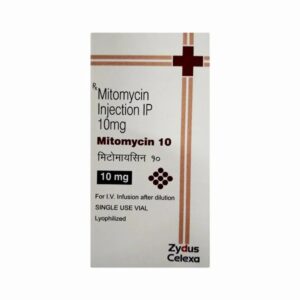Mitomycin 10 Mg Injection
Product Description
Mitomycin is an antineoplastic agent derived from the bacterium Streptomyces caespitosus. It is primarily used in the treatment of various types of cancer, including bladder cancer, gastric cancer, and pancreatic cancer. Mitomycin works by inhibiting DNA synthesis, which ultimately leads to cell death. The injection form allows for direct administration into the bloodstream, ensuring rapid distribution and effectiveness in targeting cancer cells.
Uses
- Bladder Cancer: Often used as a chemotherapy agent for superficial bladder tumors.
- Gastric Cancer: Administered in combination with other chemotherapeutic agents for advanced gastric cancer.
- Pancreatic Cancer: Utilized in certain regimens for treating pancreatic malignancies.
- Other Cancers: May be used off-label for various other malignancies as determined by oncologists.
Technical Data
| Parameter | Details |
|---|---|
| Generic Name | Mitomycin |
| Strength | 10 mg |
| Formulation | Injection (IV) |
| Indications | Bladder cancer, gastric cancer, pancreatic cancer, and other malignancies |
| Mechanism of Action | Alkylating agent that inhibits DNA synthesis |
| Administration Route | Intravenous (IV) |
| Storage Conditions | Store at room temperature (20-25°C) |
| Shelf Life | Typically 24 months from the date of manufacture |
| Side Effects | Nausea, vomiting, myelosuppression, renal toxicity, and pulmonary toxicity |
| Contraindications | Known hypersensitivity to mitomycin, pregnancy, and breastfeeding |
| Drug Interactions | May interact with other chemotherapeutic agents and anticoagulants |
Key Points
- Mitomycin is a potent chemotherapeutic agent used primarily for treating specific cancers.
- It is crucial to monitor patients for side effects, especially myelosuppression and renal function.
- The drug should be administered under the supervision of a qualified healthcare professional experienced in chemotherapy protocols.
Conclusion
Mitomycin 10 Mg Injection is a vital component in the arsenal against certain cancers, providing oncologists with a powerful tool for treatment. Its effectiveness, however, must be balanced with careful monitoring for potential side effects and interactions with other medications.

